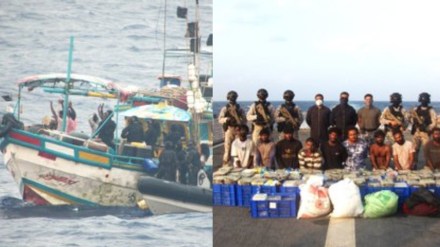The Indian Navy, in collaboration with the Sri Lankan Navy, has once again successfully intercepted narcotics smugglers operating in the Indian Ocean. The latest operation, conducted on November 24 and 25, 2024, resulted in the seizure of approximately 500 kg of Crystal Methamphetamine from two Sri Lankan-flagged fishing boats. This interception follows a coordinated operation based on intelligence shared by the Sri Lankan Navy, marking another significant step in the fight against narcotics trafficking in the region.
The operation was launched after receiving credible information about the boats’ involvement in smuggling drugs. The Indian Navy deployed Long Range Maritime Patrol Aircraft and Remotely Piloted Aircraft, with support from the Information Fusion Centre (Indian Ocean Region) in Gurugram. These aerial assets, alongside an Indian Navy ship, identified the vessels and coordinated the boarding operation. The two boats, their crews, and the seized narcotics were handed over to Sri Lankan authorities for further action. This operation underscores the growing collaboration between India and Sri Lanka in addressing maritime security threats, especially narcotics trafficking.
India’s location, positioned between the world’s two major drug-producing regions—the Golden Crescent (Afghanistan, Pakistan, Iran) and the Golden Triangle (Myanmar, Laos, Thailand)—has made it a key transit point for smuggling. Over the years, drug cartels have increasingly turned to maritime routes to bypass ground enforcement, exploiting the vastness of the sea and the limited monitoring capacity. The Indian Navy and Coast Guard are actively engaged in dismantling these smuggling networks, despite the challenges posed by the expansive maritime domain.
Earlier this week, on November 26, 2024, the Indian Coast Guard made another major breakthrough, seizing over 6,000 kg of methamphetamine from a Myanmar-flagged boat in the Andaman and Nicobar Islands. This is one of the largest drug seizures ever recorded in India. The Coast Guard spotted the suspicious vessel, Soi Wai Yan Htu, during a routine surveillance flight. The Dornier aircraft’s crew identified the boat near Barents Island, part of India’s Exclusive Economic Zone (EEZ), prompting an immediate response from the Coast Guard’s Fast Patrol Vessel, ICG Aruna Asaf Ali. Despite challenging weather conditions, the Coast Guard intercepted the vessel, arrested six smugglers, and seized the drugs hidden in sacks.
The methamphetamine recovered in this operation is valued at several thousand crores in the international market, highlighting the scale of the illicit drug trade. The seizure adds to the Indian Coast Guard’s growing tally, having now intercepted a total of 12.86 tonnes of drugs since its inception. The Coast Guard’s success is part of its broader strategy to combat drug trafficking through enhanced surveillance capabilities, including the use of both aerial and maritime platforms to monitor vast oceanic areas.
This surge in narcotics trafficking is a significant concern for India, as the drug trade fuels other forms of transnational crime, including terrorism and human trafficking. The economic and social consequences of widespread drug addiction are also a growing threat, with drug abuse increasingly becoming a public health crisis in India.
India’s strategic position makes it a critical player in global efforts to disrupt the international drug trade. The close cooperation between the Indian Navy and Coast Guard, along with neighbouring countries like Sri Lanka, plays a vital role in securing the region. These joint operations demonstrate the importance of international collaboration in tackling the complex issue of maritime drug trafficking.
As smugglers continue to adapt their tactics, the Indian Navy and Coast Guard remain vigilant, leveraging advanced technology and inter-agency cooperation to protect the seas and curb the growing narcotics trade.
